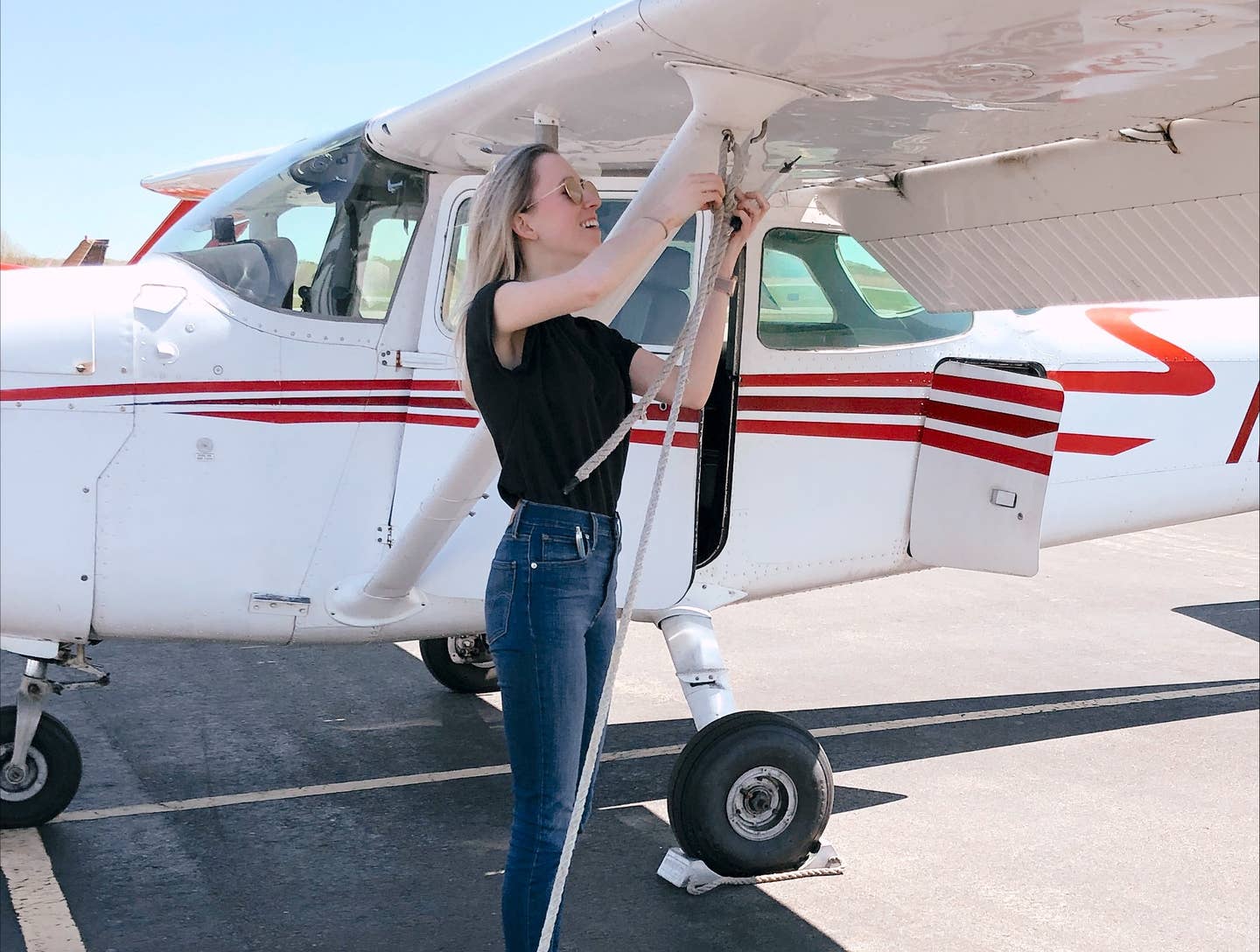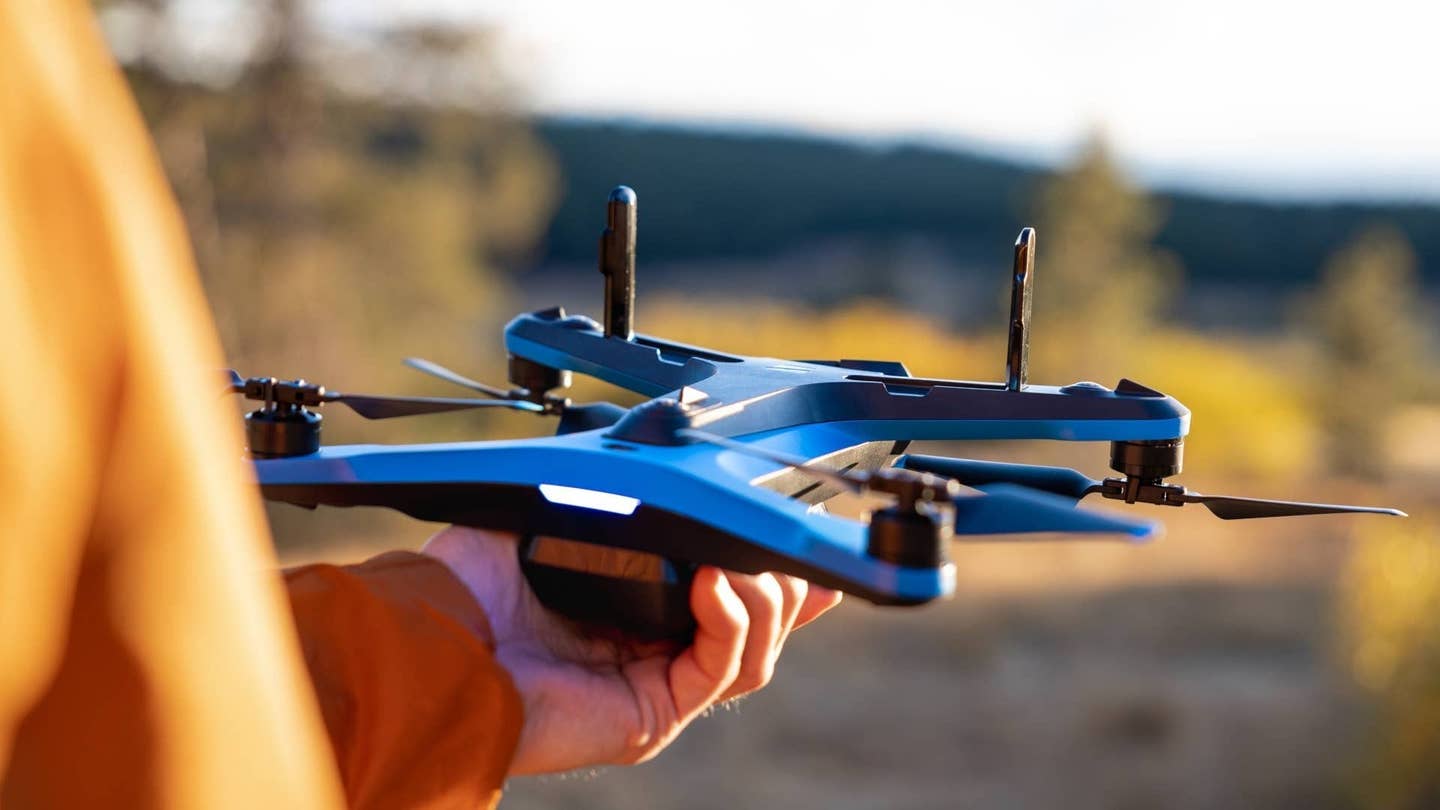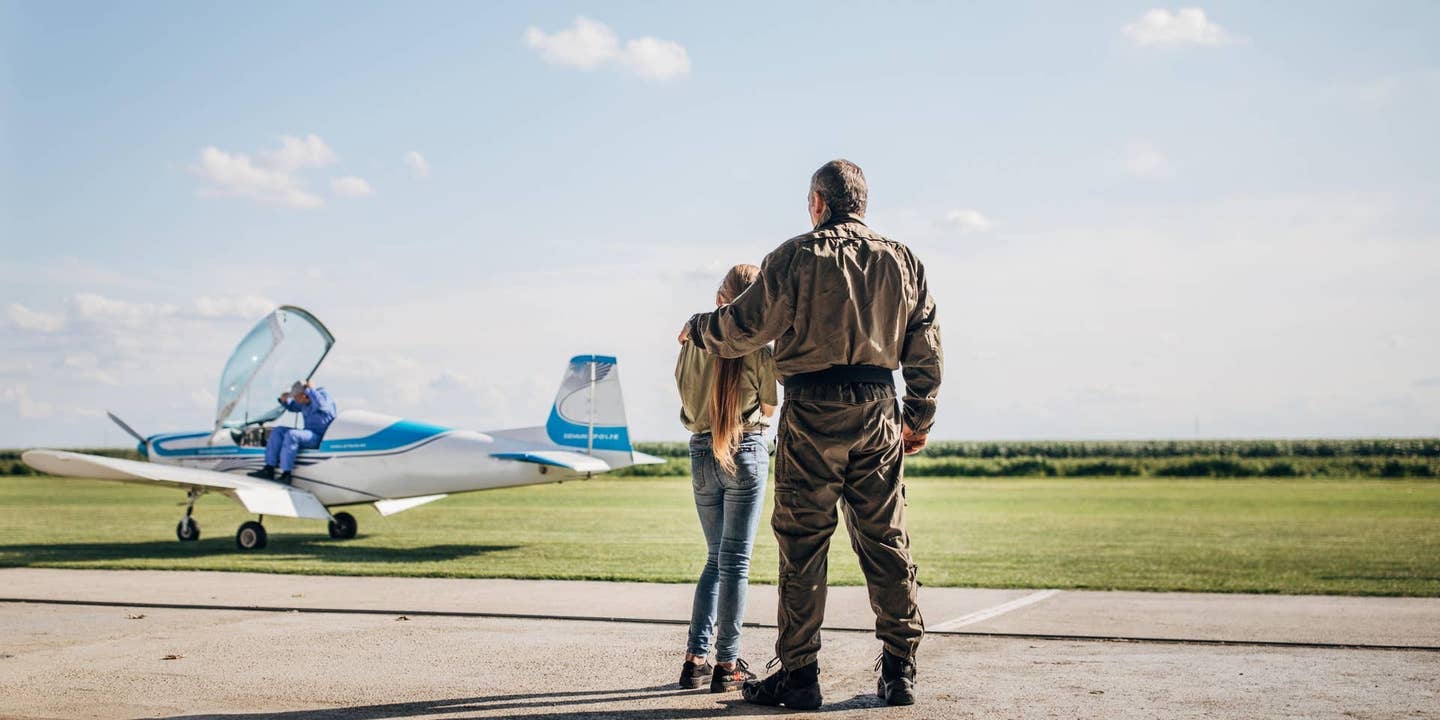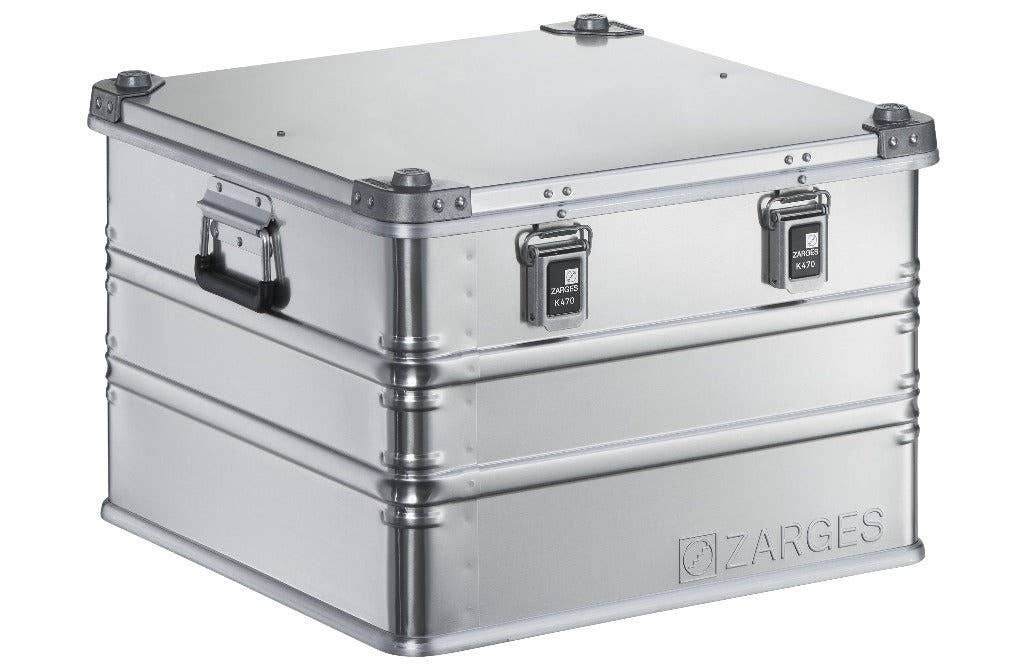How to Pick and Use Aircraft Tiedowns
Explore the best aircraft tiedowns to ensure your airplane’s safety on any surface.

Different tiedowns are designed for specific aircraft sizes and weights. [Photo by Carly Chamerlik | Flying Magazine]
Not every plane can be stored in a hangar to protect it from adverse weather conditions, such as strong winds or storms. Therefore, aircraft tiedowns are an excellent alternative method to securing a parked airplane and prevent it from moving.
There are several types of tiedown systems available on the market, each tailored to different needs and conditions. Let’s explore the different choices and add one of them to your list of aviation supplies today.
Quick Look: 6 Best Aircraft Tiedown Systems
- Best for functionality: FlyTies Aircraft Tiedown Anchoring System Kit
- Best for load capacity: Storm Force Aircraft Tiedown System
- Best for ease of use: The Claw Aircraft Tiedown Kit
- Best for simplicity: Flight Gear Pull-Down Tiedown Set
- Best for affordability: Flight Gear All-Weather Tiedowns
- Best for versatility: Tie Boss Tiedown Kit
FlyTies Aircraft Tiedown Anchoring System Kit
Best for: Functionality
The FlyTies Aircraft Tiedown Anchoring System Kit is a functional, omnidirectional tiedown system that provides secure anchoring from multiple directions for maximum security. Unlike traditional tiedowns that might only secure an aircraft from one or two points, the FlyTies system uses three hubs to distribute forces evenly across all directions. This setup enhances stability and reduces the risk of the aircraft being moved or damaged by strong winds.
Key features and specifications
- Included supplies: Three aluminum hubs with forged steel eye bolts; nine 14-inch steel stakes; three 12-foot polypropylene ropes; easy-out extraction tool; rugged compact canvas tote bag
- Load capacity: 3,600 pounds when all three anchors are installed
- Surface type: Designed for use on most unpaved surfaces
- Additional features: Kit weighs 8 pounds, 10 ounces; easy to assemble; corrosion resistant; self-cleaning action; compatible with all types of small aircraft
- Warranty: Limited lifetime
Disadvantages
- The kit does not include a hammer, which is necessary for driving the stakes into the ground.
- Customer reports have stated the rope ends have started to fray after several uses.
Price: $149.95
Storm Force Aircraft Tiedown System
Best for: Load capacity
The Storm Force Aircraft Tiedown System is a lightweight yet extremely durable omnidirectional tie down system for small aircraft. It can support 4,200 pounds or more of force per unit, making it stronger than most of its competitors. The Storm Force system further maximizes tiedown strength by utilizing the FAA-recommended 45-degree tiedown method.
Key features and specifications
- Included supplies: Three metal crossmembers; carbon steel hammer; 15 zinc-coated metal spikes; three 10-foot sections of high-tensile strength rope; carrying bag
- Load capacity: 4,200 pounds when all three anchors are installed
- Surface type: Designed for use on most unpaved surfaces
- Additional features: Kit weighs 8 pounds, 9 ounces; components are powder-coated in safety yellow for increased visibility; compatible with all types of small aircraft
- Warranty: Limited lifetime
Disadvantages
- The initial investment might be higher compared with simpler tie down solutions.
- The metal components, although durable, may require regular maintenance to prevent rust and wear, especially if used frequently in harsh environments.
Price: $159.95
The Claw Aircraft Tiedown Kit
Best for: Ease of use
The Claw Aircraft Tiedown Kit is an easy to use and highly effective aircraft anchoring system. Each kit contains three collapsible triangular mechanical anchors, called The Claw. The Claw’s patented design ensures that the harder the anchor is pulled, the more it grips the earth, making it highly reliable in strong winds.
Key features and specifications
- Included supplies: Three collapsible triangular mechanical anchors; nine spikes; one hammer with a custom head; 20-foot rope; carrying bag
- Load capacity: 3,600 pounds when all three anchors are installed
- Surface type: Designed for use on most unpaved surfaces
- Additional features: Low-profile design reduces tripping hazards; compatible with all types of small aircraft
- Warranty: Limited lifetime
Disadvantages
- While versatile, the effectiveness of The Claw can vary depending on the soil type.
- Although generally easy to use, setting up the anchors can still take some time, especially in harder or rocky soils.
Price: $119.95
Flight Gear Pull-Down Tiedown Set
Best for: Simplicity
The Flight Gear Pull-Down Tiedown Set is a simple and affordable system to tie down an aircraft. Each coated snap hook attaches to the aircraft while the other hook attaches to the anchor point. The rope is then effortlessly pulled down while the ratcheting mechanism locks the rope into place, holding it tight and keeping the aircraft secure.
Key features and specifications
- Included supplies: Two 10-foot ropes and one 6-foot rope, each measuring three-eighths inches in diameter; three ratcheting mechanisms; six coated snap hooks; carrying bag
- Load capacity: 750 pounds when all three anchors are installed
- Surface type: Designed for use on surfaces with anchoring system installed
- Additional features: Highly visible orange rope color; accommodates both high and low wing aircraft; optional custom embroidery
- Warranty: One year
Disadvantages
- The load capacity is low compared with other aircraft tiedown straps, which may not be ideal for large or heavy aircraft.
- The kit does not come with an anchoring system, which may not be ideal for operations at remote locations.
Price: $49.95, plus $9.95 for optional embroidery
Flight Gear All-Weather Tiedown
Best for: Affordability
The Flight Gear All-Weather Tiedown is engineered to provide the ultimate affordable peace of mind when securing an aircraft. With one quick pull, the tiedowns offer a tight, secure hold, thanks to the premium-coated snap hooks that assure the aircraft stays in place. The black e-coated cam buckle features a user-friendly push lever for easy release, making it quick and hassle-free to secure and unsecure any aircraft.
Key features and specifications
- Included supplies: Two 10-foot straps and one 6-foot strap; three black e-coated cam buckles; six premium-coated snap hooks; storage bag
- Load capacity: 3,300 pounds when all three anchors are installed
- Surface type: Designed for use on surfaces with anchoring system installed
- Additional features: Available in high-visibility orange or jet black; accommodates both high and low-wing aircraft; optional custom embroidery
- Warranty: One year
Disadvantages
- Contains materials that may expose users to chemicals known to cause cancer, birth defects, or other reproductive harm.
- The kit does not come with an anchoring system, which may not be ideal for operations at remote locations.
Price: $39.95, plus $9.95 for optional embroidery
Tie Boss Tiedown Kit
Best for: Versatility
The Tie Boss Tiedown Kit is versatile and can be used for more than just tying down an aircraft. This innovative tiedown system features built-in serrated jam cleats, eliminating the need for complicated knots and ratchets. Tie Boss is quick, efficient, and weighs less than most of its competitors, saving its users time and effort even on the toughest aircraft tiedown jobs.
Key features and specifications
- Included supplies: Three 10-foot solid braided polypropylene ropes; three built-in serrated jam cleats; six zinc-plated steel hooks; carrying bag
- Load capacity: 900 pounds when all three anchors are installed
- Surface type: Designed for use on surfaces with anchoring system installed
- Additional features: Accommodates both high- and low-wing aircraft; optional custom embroidery
- Warranty: One year
Disadvantages
- The kit may be out of stock due to its popularity. However, individual tiedowns may be purchased separately ($24.95).
- The kit does not come with an anchoring system, which may not be ideal for operations at remote locations.
Price: $79.95, plus $9.95 for optional embroidery
Factors to Consider When Choosing a Tiedown
When choosing an aircraft tiedown, several factors must be looked at to ensure the safety of the aircraft and reliability of the system.
Aircraft Type and Weight
Different tiedowns are designed for specific aircraft sizes and weights. Selecting a system with the appropriate load capacity helps prevent restraints from failing under stress. While a light aircraft may require simpler and lighter tiedowns, heavier or larger aircraft demand robust systems with higher load capacities to withstand the forces exerted on them.
Weather Conditions
High wind speeds, heavy precipitation, and extreme temperatures can all impact the effectiveness of a tiedown system. Stronger wind gusts require tiedowns with higher load capacities to assure the aircraft remains secure on the ground. Tie-downs that are resistant to rust and corrosion perform better in wet conditions, extending their service life and maintaining safety standards. Temperature fluctuations can also affect tiedown materials. Extremely cold temperatures may cause some materials to become brittle, while excessive heat can weaken them.
Ground Conditions
The type of ground (e.g., soft, hard, uneven) can influence tiedown selection. While soft ground may require longer stakes, hard or rocky ground may require specialized tools to penetrate tough surfaces. Uneven terrain adds further complexity, often necessitating adjustable and versatile tiedown solutions that can adapt to varying ground levels and textures. For operations at airports with anchoring systems already installed, a less complex tiedown system can be used.
Frequency of Use
If the tiedown is used frequently, then durability and ease of use are important factors to consider. A durable tiedown can withstand repeated use without breaking or wearing down. Ease of use, on the other hand, assures the tiedown can be set up and taken down quickly, saving time and reducing the risk of improper installation. Frequent use of the system also warrants the necessity of low-maintenance tiedowns to minimize the time and effort required for upkeep.
Budget
Tie-downs vary in price, so budget should be considered when selecting a system. While it is important to invest in a system that offers reliability and safety, there are affordable options available that do not skimp on quality. High-end tiedown systems tend to include additional features, such as corrosion resistance, enhanced load capacities, and user-friendly installation mechanisms. More budget-friendly options, on the other hand, offer basic but still functional features that are suitable for less demanding environments.
Tips for Safe and Effective Tiedown Use
To ensure the safety and security of an aircraft, it is essential to consider the following tips for tiedown use.
Follow Manufacturer's Instructions
Always refer to the manufacturer’s guidelines specific to the tiedown system being used. These instructions provide the most accurate information on how to correctly position and secure the tiedowns relative to the aircraft's design. Incorrect installation can lead to insufficient support, which might result in shifting or damage to the aircraft, especially in adverse weather conditions.
Inspect Regularly
Regularly inspect the tiedowns for signs of wear, damage, or loose components to preclude any potential failures. Over time, airplane tiedown straps can experience wear and tear due to constant exposure to various weather conditions and the mechanical stresses of securing an aircraft. By addressing minor issues promptly, more significant problems can be prevented down the road.
Consider Additional Safety Measures
Consider taking extra safety measures, such as using wheel chocks and other tiedown devices, to further reduce the risk of aircraft movement. This practice is particularly important for heavier aircraft, which may require more robust anchoring systems to keep them secure.
Pick Your Aircraft Tiedowns Today
When an aircraft is not flying, it is important for any pilot or aircraft owner to store or secure it properly to prevent damage from any external forces. Selecting an appropriate tiedown system is an excellent alternative method for those without hangar space. Therefore, investing in reliable aircraft tiedown straps is crucial to safeguarding the aircraft against movement or damage and preventing potentially costly repairs.
We hope our comprehensive guide has helped you narrow down the tiedown system appropriate for your specific aircraft’s weight, size, and operating environment. Skip the long store lines, and let’s add one of these airplane tiedowns to your virtual cart today. Most systems ship within a couple of days and are ready for immediate use.
Now that you have selected your aircraft tiedowns, make sure to pick out the rest of you gear that you need for your flight.
FAQ
What is an aircraft tiedown?
An aircraft tiedown is a system used to securely anchor an aircraft to the ground, preventing it from being moved by wind, jet blasts, or other environmental forces.
What kind of rope is best to tie down an aircraft?
When selecting a rope to tie down an aircraft, it is crucial to choose one that is strong, durable, and resistant to environmental factors. Nylon and polypropylene ropes are often preferred due to their high tensile strength and resistance to abrasion, UV radiation, and moisture.
What is the purpose of a tiedown?
The purpose of a tiedown is to securely anchor an aircraft to the ground, preventing it from moving due to external forces, such as strong gusts of wind or storms.
Are planes tied down on aircraft carriers?
Aircraft on carriers are indeed tied down, but the systems and methods used are more robust to endure the harsh maritime environment and the dynamic conditions of a moving vessel.
Top Selling Aviation Items for December
FLYING has compiled a list of the 15 most popular items our readers purchased in December:

Sign-up for newsletters & special offers!
Get the latest FLYING stories & special offers delivered directly to your inbox






